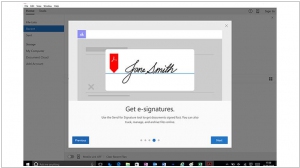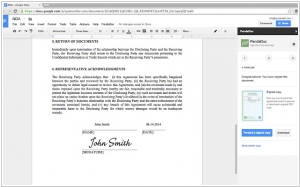Adobe Sign vs PandaDoc
May 19, 2023 | Author: Michael Stromann
Adobe Sign and PandaDoc are both popular digital document management solutions that streamline the process of creating, sending, and signing documents electronically. However, there are key differences between the two platforms.
Adobe Sign, part of the Adobe Document Cloud suite, offers a comprehensive set of features for electronic signatures and document workflows. It integrates seamlessly with other Adobe products, such as Adobe Acrobat and Adobe Creative Cloud, and provides a robust and secure platform for managing document approvals, tracking, and compliance. Adobe Sign is known for its extensive integrations, scalability, and enterprise-grade security, making it a suitable choice for businesses of all sizes.
PandaDoc, on the other hand, is a versatile document management platform that goes beyond e-signatures. It offers a range of features for document creation, collaboration, and automation. In addition to e-signatures, PandaDoc allows users to create interactive and dynamic documents with rich media, collect payments, and track document performance. PandaDoc is known for its user-friendly interface, customizable templates, and advanced analytics capabilities, making it a popular choice for sales teams and small to mid-sized businesses.
See also: Top 10 Electronic Signature software
Adobe Sign, part of the Adobe Document Cloud suite, offers a comprehensive set of features for electronic signatures and document workflows. It integrates seamlessly with other Adobe products, such as Adobe Acrobat and Adobe Creative Cloud, and provides a robust and secure platform for managing document approvals, tracking, and compliance. Adobe Sign is known for its extensive integrations, scalability, and enterprise-grade security, making it a suitable choice for businesses of all sizes.
PandaDoc, on the other hand, is a versatile document management platform that goes beyond e-signatures. It offers a range of features for document creation, collaboration, and automation. In addition to e-signatures, PandaDoc allows users to create interactive and dynamic documents with rich media, collect payments, and track document performance. PandaDoc is known for its user-friendly interface, customizable templates, and advanced analytics capabilities, making it a popular choice for sales teams and small to mid-sized businesses.
See also: Top 10 Electronic Signature software
Adobe Sign vs PandaDoc in our news:
2020. Sales document workflow startup PandaDoc gets $30M
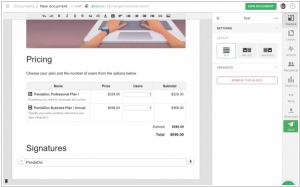
PandaDoc, a startup that specializes in a comprehensive digital sales document workflow encompassing proposals, electronic signatures, and payment collection, has recently announced a $30 million Series B extension. The company's growth strategy revolves around leveraging their eSignature tool as a means to onboard users onto their platform. In response to the pandemic's impact in the United States, PandaDoc made their eSignature tool available for free in March. This decision has proven to be an effective lead magnet, attracting more individuals to become familiar with the company. Once users engage with the platform, they have the opportunity to explore a wider range of tools, potentially converting into paying customers.
2015. Sales content managment service PandaDoc gets $5M
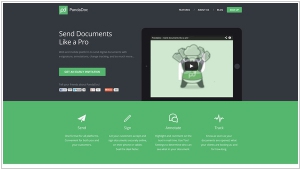
The automation-focused startup PandaDoc has recently secured a $5 million investment. PandaDoc specializes in streamlining the creation of quotes, proposals, and contracts through its platform. Acting as a content layer that integrates with CRM tools, the product currently supports popular platforms such as Salesforce.com, Zoho, Pipeliner, and Base. It also collaborates with Zendesk, facilitating the distribution of renewal contracts and other relevant information by customer service personnel. To simplify the content creation process for sales teams, PandaDoc offers a range of pre-defined templates that can be tailored to suit each company's specific requirements. These templates encompass various components, including standard introductory content and pricing tables with predefined discounts.
2015. Adobe launches Document Cloud for Acrobat and EchoSign
Adobe is set to unveil its third cloud offering, known as Adobe Document Cloud, joining the ranks of Creative Cloud and Marketing Cloud. At the core of this new venture is Acrobat DC, a comprehensive version of Acrobat designed for desktop, web, and mobile platforms. It will introduce free e-signing tools leveraging Adobe EchoSign, along with advanced image handling capabilities and OCR technology. Additionally, Adobe is introducing Fill and Sign, a new mobile application, as well as an enhanced Acrobat enterprise solution that includes features such as fine-grained permission controls and integrations with third-party platforms. These new applications enable users to effortlessly create and edit PDFs directly from their devices. For instance, users can capture a photo of a document using their smartphone and automatically convert it into a PDF format. The primary aim is to provide a cohesive user experience across all platforms, with e-signing capabilities serving as a prominent feature.
2011. Adobe acquires electronic signature company EchoSign
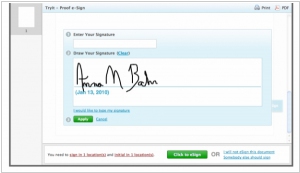
Adobe has recently completed the acquisition of EchoSign, a web-based provider specializing in electronic signatures and signature automation. The exact financial details of the acquisition were not disclosed. With this strategic move, Adobe aims to integrate EchoSign's electronic signature technology into its document exchange services platform. This integration is expected to streamline the process of obtaining signatures for documents, reducing both time and costs while simplifying the overall workflow. As a consequence of this acquisition, Adobe has decided to discontinue its own cloud-based electronic signature service, known as eSignatures or eSign, which was introduced in May of the previous year. Currently in beta, eSign will be phased out and eventually discontinued in the near future.

